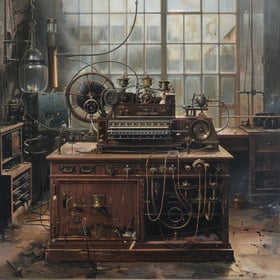Forecasting the Future: Keeping Pace with Rapid Innovation Cycles
Why rapid iteration cycles require corporations to stay connected to the innovation economy, and how they can keep pace with innovation in the face of exponential advancement.
.png?width=500&height=500&name=Ian%20Bergman%20Light%20Yellow%20(compressed).png)
Forecasting the Future: How corporations can keep pace with innovation in the face of exponential advancement.
When I talk to corporate leaders, experienced investors, and startup founders building the future of technology, I repeatedly hear the same concerns:
- “I don’t know what’s coming next anymore."
- “The pace of change in technology is rapid and increasing.”
- “Differentiating signal from noise is really tough.”
- “I can’t plan.”
The bottom line — innovation cycles are shortening and compressing. It has become increasingly hard to predict and plan for the future, and leaders are struggling to keep up. The 3-horizon model is arguably dead.
There’s a tl;dr here - if you can’t predict what’s coming, and that’s impacting your ability to plan, then you might as well get deeply connected to the people who are building the future. (startups)
Nothing brings the pace of advancement home more than what we see in artificial intelligence (AI). In the blink of an eye, AI has gone from an amorphous concept and a label liberally applied to everything from fancy sorting algorithms to machine learning models to advanced, flawed chatbots to a technology capable of generating imagery out of thin air, arguably passing the Turing test, navigating a car through complex urban environments, and hinting at the unbelievable power to create (and shape) reality with just a few words.
Corporations, specifically, are challenged to keep pace with new technologies in an environment that’s experiencing a significant acceleration in technological progress.
That leaves us with some of the most pressing questions facing corporate innovators today: Where do we go from here? And how can corporations adapt to the ever-changing landscape of technology to remain resilient in uncertain times?
The answer to this lies in an updated theory of innovation - one grounded in the notion that if you can no longer plan for the future, the least you can do is stay well-connected to the people building it.
A look back in time and the increasing pace of change
 Today is not the first time humans have made seemingly sudden advances in what we can achieve. Take the Enlightenment, for instance, or the Industrial Revolution—both were times of significant knowledge exchange and technological innovation.
Today is not the first time humans have made seemingly sudden advances in what we can achieve. Take the Enlightenment, for instance, or the Industrial Revolution—both were times of significant knowledge exchange and technological innovation.
What we sometimes forget, however, is that the Enlightenment spanned nearly 150 years. Communication during that period required days, weeks, or months to send and receive a single reply. The great thinkers of the age would be able to ponder for significant periods of time before moving correspondence forward.
The Industrial Revolution, spanning over 80 years, significantly increased human productivity through the application of steam engines, inventions such as the spinning jenny and the cotton gin, and other novel tools. But towards the end of the industrial revolution came the advent of an even greater amplifier of human productivity - the telegraph.
In 1837, the electric telegraph was developed, and for the first time in human history, we were able to share information and communicate nearly instantaneously over long distances. This unlocked the opportunity for what humans can achieve when we share knowledge with each other in real time.
Fast forward to today–the last half-century has been defined by fundamental changes in how technology has empowered humans to communicate, think and create. These changes, or “platform shifts”, have enabled humans to share knowledge and communicate more efficiently as a result of each new iteration. From the first PC to the internet, followed by mobile and cloud computing, each technological leap paved the way for companies to build new experiences, create new distribution channels, and leverage larger data sets to shape the future of commerce.
The problem
Today, we are struggling to keep up with just what we created through ~2015. Social networks let (mis)information and ideas spread faster than anyone can critically think about or respond to them. Emails, texts, DMs across dozens of channels ask for an instantaneous response. I’ve had colleagues constantly ask “when do we get to stop and think?”
The accelerating pace of innovation today makes it nearly impossible to predict what our capabilities could look like years down the road. New applications of artificial intelligence and machine learning are built and distributed faster than ever before, impacting how we work, share, and communicate with each other. These advancements driven by technology create ripple effects across society, reducing our ability to respond to the changing world around us. As a result, the time horizon of which anybody can forecast the future of their business continues to shorten. Years. Months. Seemingly, weeks.
To compound this problem is the creation of new user-friendly tools that lower the barriers to entry of building advanced systems. The democratization of innovation has led to more applications of novel technology that make it increasingly difficult to keep up with and understand.
I’m personally excited by these advancements. I love the brave new world we’re creating for ourselves. But we need to stop, think and ask ourselves some questions - not the least of which is, “how do we keep up?”
As corporations grapple with the unprecedented speed of innovation, leaders are tasked with positioning their organizations to embrace rapid change and serve their customers of tomorrow. And they’re finding it extremely challenging to decide how to do so.
How can corporations adapt in an environment of exponential advancements?
In a world where you can’t predict the future, you might as well stay closely connected to the people building it. This is a fundamental shift in how we think about corporate innovation and one that I believe will define the next era of companies working to stay ahead of the competition.
the competition.
In a world where each new iteration of technological progress happens quicker than the last, it’s no longer a viable corporate strategy to believe you can keep up with the pace of innovation on your own.
If the increasing magnitude of each new platform shift over the past 50 years has taught us one thing, it’s that we should expect to encounter new opportunities and challenges that we haven’t experienced before.
To approach these novel changes and be able to forecast the future with any degree of certainty, corporate leaders need to prioritize three key areas of their organizations to stay competitive in an ever-changing environment.
1) Prioritize collaboration with outside leaders
We’re in the early stages of seeing possible real-world applications of artificial intelligence and machine learning and how these technologies impact consumer expectations. In the face of this change, many leaders are feeling lost. Rather than trying to respond to these changes on your own, it’s crucial to open up and prioritize collaboration with your industry peers.
Open innovation is by no means a new concept. But it is one that most organizations have struggled to embrace truly, and there’s a new twist - it’s becoming less about solutions and more about ideas and what’s possible, built in collaboration with engineers, thinkers, peers, and - yes - competitors.
Deliberately seeking outside partners can drive transparency and partnership opportunities across industries as leaders share key learnings around customer expectations, data architecture, new use cases for emerging technologies, and more. Leaders should set aside time to regularly meet with outside researchers, academics, and other thought leaders in the space to keep a pulse on the questions and challenges others are spending time on. Viewing your competitors as less of a threat and more as collaborators will be the fuel to corporate innovation in a world where leaders need to respond quickly to each incremental advancement in our capabilities.
The next decade of corporate competitive advantage won't be defined by your technical capabilities or novel ideas but by how fast you can respond to the change being imposed on you. To respond to change effectively, business leaders need to embrace open innovation - in a new, evolved way! - by prioritizing collaboration and the sharing of ideas.
2) Structure your organization to embrace change
Risk aversion to new ways of doing business will prove to be the riskiest decision of all for a company. Organizational culture, incentive mechanics, and team structure remain some of the biggest roadblocks to successfully adopting innovation today.
Reducing friction across an organization will counter its natural instincts to preserve the value that has been created over the years. Entire libraries have been written on this. While we won’t dive into the details today, these initiatives will need to be targeted and deliberate, and organizations built to efficiently adapt to change from the inside and outside will be best set up to win - or even just survive.
3) Connect with the startup community
Organizations must simply be more efficient and effective at immersing themselves in the firehose of innovation coming out of the startup community.
To do this well, they need to:
1) identify the challenges that make sense to solve with outside innovation
2) deploy resources dedicated to accessing this innovation
3) ensure they are set up internally to take action on what they learn
Over the years, corporations have set up Corporate Venture Capital arms (CVCs), built incubators and accelerators, deployed scouts, and set up offices in innovation hubs. There have been great successes - and a lot of “innovation theater” - coming out of this work.
I believe that the world will increasingly move towards a purer form of knowledge sharing—high-bandwidth, “capital D” Dialogue with the people and teams building the future. By leveraging tight, close-loop discussions, corporate leaders can understand what the cutting-edge technology is, and who to pay attention to. In some ways, corporate leaders are going to need to model their insight on the same discovery patterns that build great startups. Immersion, access, knowledge.
This is how corporations will move past outdated innovation strategies and respond with more agility, more confidence, to an uncertain and rapidly changing future.
What we know
 The pace of innovation is increasing. This increase means that we are less able to predict the future every year. Each new iteration of technological progress is coming quicker than the last, and corporations face the challenge of needing to think and respond faster than ever before.
The pace of innovation is increasing. This increase means that we are less able to predict the future every year. Each new iteration of technological progress is coming quicker than the last, and corporations face the challenge of needing to think and respond faster than ever before.
The good news is that corporate leaders have somewhere to turn. Plugging themselves into the innovation and ideas coming from the startup ecosystem will pay dividends.
Corporate innovators who position their companies the best will do so by opening up to the outside world and connecting with other thought leaders, technologists, and entrepreneurs.
In a world where change is rapid, expertise is diffuse, and the future is impossible to predict, real competitive advantage will side with those most willing to engage with the builders, share and learn from others’ ideas, and use that Dialogue to inform plans that adapt as needed.
Alchemist connects a global network of enterprise founders, investors, corporations, and mentors to the Silicon Valley community.
Alchemist Accelerator is a global venture-backed accelerator focused on accelerating seed-stage ventures that monetize from enterprises (not consumers). The accelerator invests in enterprise companies with distinctive technical founders and provides founders a structured path to traction, fundraising, mentorship, and community during the 6-month program.
AlchemistX partners with forward-thinking corporations and governments to deliver innovation programs worldwide. These specialized programs leverage the expertise and tools that have fueled Alchemist startups’ success since 2012. Our mission is to transform innovation challenges into opportunities.
Join our community of founders, mentors, and investors.

